#valjean et cosette
Text
Shout out to Victor Hugo for making the original adoptive father - daughter relationship in media. Gotta be one of my favorite trope
#found father and daughter#les miserables#valjean et cosette#i have feelings about them ok?#this trope in general tbh#ellie and joel#ciri and geralt#el and hopper
21 notes
·
View notes
Text
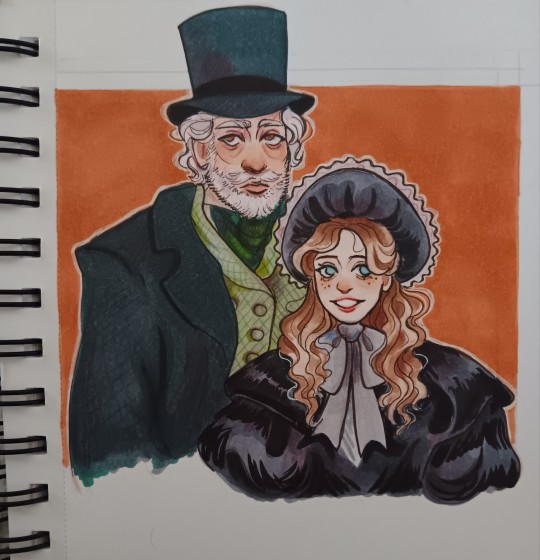
monsieur leblanc et mademoiselle lanoire (happy jean valjean adopts cosette day.)
#im quite happy with how this one turned out#coping with my festivity related bad moods by re-reading the brick#les mis#les miserables#jean valjean#cosette#my art
394 notes
·
View notes
Text
A fun pun from yesterday's Les Mis chapter:
Gavroche says: “And make haste, Monsieur What’s-your-name, for Mamselle Cosette is waiting.”
This line in French is: “Et dépêchez-vous, monsieur Chose, puisque mamselle Chosette attend.”
"Chose" means "thing" so Gavroche is kind of calling Jean Valjean "monsieur thingamajig" since he doesn't know Valjean's name. The funny part is that this can be made into a pun when he refers to Cosette as "Chosette" instead, which is just the word "chose" with a feminine "ette" tacked on, making them Monsieur Chose and Mamselle Chosette.
Rose attempts the translation of this pun more than Hapgood does, but neither express how well this works because of Cosette's name.
397 notes
·
View notes
Text
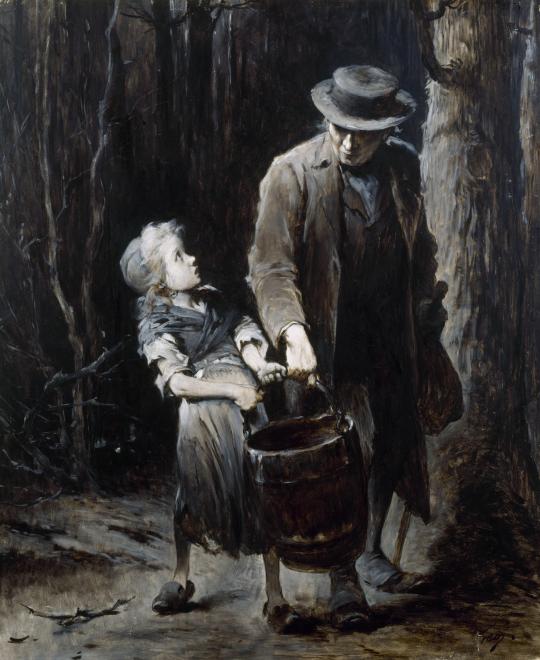
From the Archives: Another painting! "Jean Valjean et Cosette", by Jean Geoffroy. Dated somewhere between 1879 to 1882.
86 notes
·
View notes
Text
Really interesting thing about Les Miserables is that it combines a number of semi-independent stories - each of which, when isolated, is a fairly standard interpretation of a given trope - into a larger, inter-connected whole; and wherever the individual archetypes interact with each other, they set the stage for the introduction of things that are less generic and cannot be treated as a one-dimensional paradigm. Such a layered "collage" is possible because of two factors: first, a large (and varied) cast of characters; second, the fact that the events in the novel span a relatively long period of time (some 40 years*).
However, unlike many historical works of similar calibre, Les Miserables usually favors a surgical approach - in a way, the individual "puzzle pieces" and their intersections matter more than the final "big picture".
When you look at the collage, you start to notice patterns and parallels: how Éponine is a distant echo of Javert, and in turn how Grantaire can be likened to Éponine; the mirrored fates of Enjolras and Gavroche; the analogous-yet-divergent fates of Valjean and Fantine, and many more.
In and of itself, the joined tale of Marius and Cosette is a variation on the theme of Werther et al. But when you broaden your perspective and consider the preceding stories of the two characters, it suddenly expands beyond the conventions of the genre. They are more than archetypical Romantic lovers: Marius - by virtue of his conflict with his grandfather and his involvement in the June Rebellion; and Cosette - owing to the detailed account of her turbulent past. The lover, the wayward son and the patriot-martyr are all characters extremely common in nineteenth-century literature - it just so happens that Marius is all three. Similarly, Cosette's childhood is a typical, if harrowing, Realistic depiction of abuse and poverty; and yet she is also the angelic, aethereal "kindred spirit" venerated by the lovestruck Marius-Werther.
Then you have Valjean, whose life is part morality play, part Positivistic* success story, part psychological study of an eternal outcast; Javert, who is simultaneously a caricature of single-mindedness, a universal parable about the dangers of blindly following authority, and Hugo's way of critiquing the reactionary police-state of Napoleon III; Éponine, at once a cautionary tale and a sympathetic look at the seedy underbelly of 'civilised' society; and bishop Myriel, both a textually canonized saint and the jolly protagonist of a pastoral about the highs and lows of life in a provincial parish.
The characters evoke emotion not because they can be losslessly stencilled into the new millenium, but because their reality is multi-faceted enough for us to become immersed in it. It's as if Hugo put a bucket-load of archetypes and genres in a well-researched and digression-prone blender, and out of that marring of ideals came something that has perhaps lost some of its everyman appeal and universality, in favor of immortalizing a kaleidoscope view of life in the early eighteen-hundreds; and yet it remains relevant because the problems he tackles are relevant still.
26 notes
·
View notes
Text

Henri Jules Jean Geoffroy - Jean Valjean et Cosette (ca. 1879)
67 notes
·
View notes
Text
Time to share this beautiful comic! this is the first part of Rene Giffey's French comic "Jean Valjean et Javert " published in (1949)
The second part is "Gavroche" and the third is "Cosette et Marius" I intend to get them later.
It’s the oldest comic in my collection so far, It's so close to the book and I'm really in love with Giffey's drawing style! I've been wanting to own it for a long time and I'm not going to lie that Fantine is the main reason for that.. I mean seriously just look it her in the cover SHE IS FLAWLESS!!


It’s SO large as you can see..

Due to it’s large size, it contains many frames per page and it’s difficult to read it.. It gives a headache tbh

Like most of Les Misérables adaptations, it begins when Valjean comes to Digne :
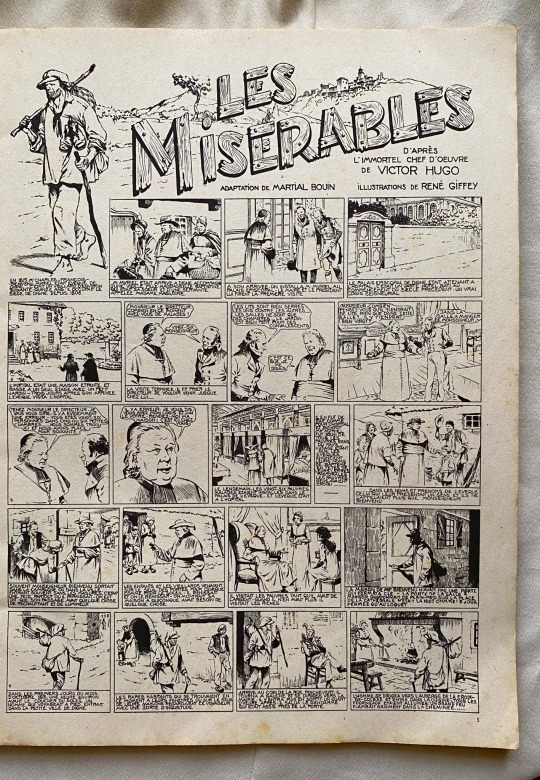
And ends when he saves one of the workers and falls into the sea :
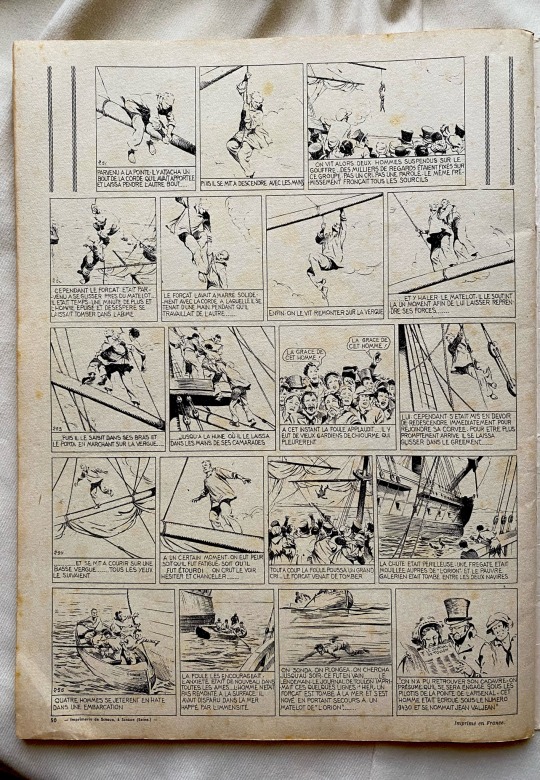
LOOK IT THIS HOT PRUNER!
Ok he looks more like a hunter..
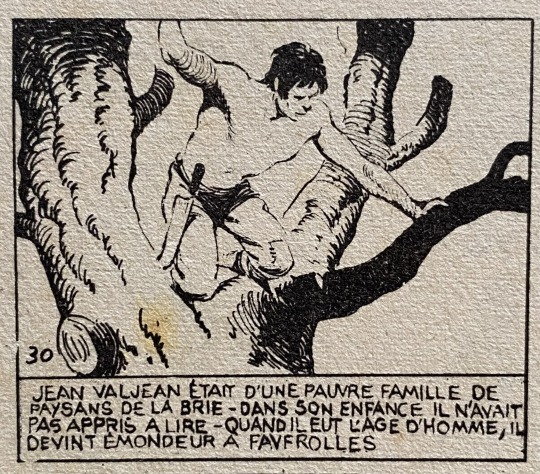
Hilarious how Valjean’s beard disappears into one of the frames here.
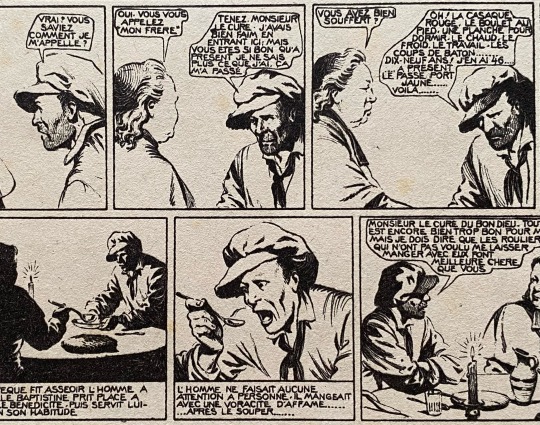
The whole way Giffey's depicts Valjean's fear and hesitation before entering the courtroom is PERFECT.
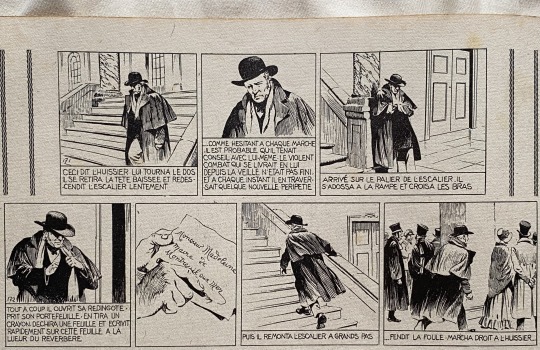

PLEASE THEY ARE SOO PRECIOUS I LOVE THEM SO MUCH
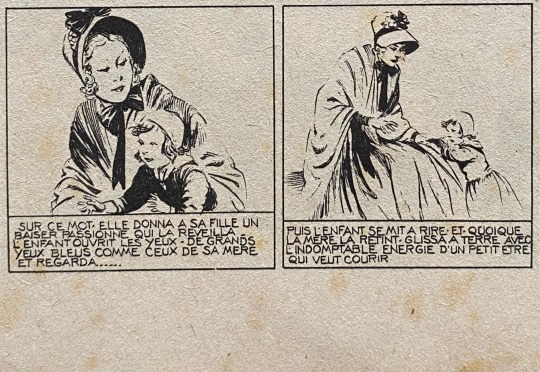
The way the soldiers hold her is awful and piss me off.
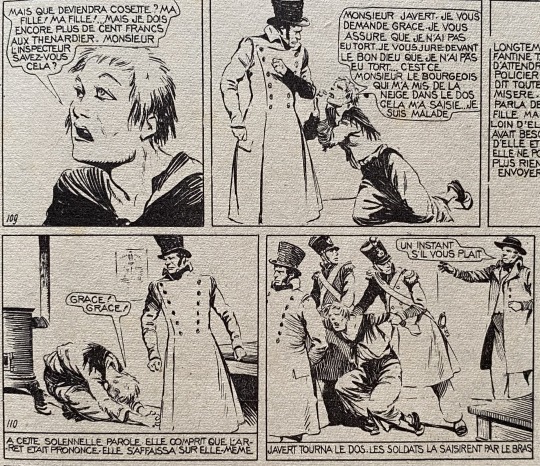
Yes, Go kick his ass please.

Love these Thénardier silhouettes frames when he loots the dead after the Battle of Waterloo.

AND SURPRISING!!
It has the moment when Valjean breaks into people houses to give them money! I think it's the only adaptation has this moment.

63 notes
·
View notes
Text
At the end of the first part, I'm not sure I know what '72 is trying to accomplish. Politics, sure. For every actor to have their chance to shout a line, for sure. It feels as if I've watched four different shows, of four different qualities, two of them quite good, one mediocre, and one bad. Many thoughts, moving in reverse:
The Gorbeau ambush occupies the last third (I would mark the start just after 1:15:00 [when the Thénardier girls drop their father's beggar's letters in the street, which are then retrieved by Marius], and the run time is almost two hours). Thénardier occupies center screen for a high percentage of this forty-five minutes—I'd argue he's the main character for this time, though the show tries to split its attention between him and Marius. He's erratic, raving, furious, violent. He's very broken in this iteration of the character, and while it is difficult to call him pitiful—he's too much of a threat—he's distinctly and peculiarly sympathetic in a manner that I don't read in the book and haven't seen in other adaptations. He's too fucked-up to be playing a game when he speaks of suicide and the unfairness of the world; his imprecations against society are not ploys to garner attention but a real expression of pain. "Sympathetic" not here at all synonymous with "likable", to be clear; again: he's a threat. A villain. Abusive. Only, the watcher is forced to ask: why?
Alain Mottet's delivery of the line "Oh! je mangerais le monde!" is as close to understated as he's capable of acting, flat and bitter, and quite effective. It is contrasted against the letter he is writing, from which he reads aloud a line pulled from III.VIII.III, "La vertu de la clémence et pitié est celle qui unit plus étroitement la société"—the intent and tone are different (and more comedic) in the novel, but here you get the sense of a man who is debasing himself before others to be allowed a place in a society he'd rather chew to pieces. Solid.
"Voulez-vous mon chapeau?" and Javert's good mood hits a different note—the show has been so goddamn grim for forty minutes that the abrupt tone shift grates, and seems cruel. Which I'm fine with, as an effect. It's unfortunate that Bernard Fresson is a little dead behind the eyes and plays a bland Javert, or in any case seems bland in comparison to a very emotive cast, and doesn't carry the scene well.
Speaking of emotive, holy shit, Hermine Karagheuz, what're you doing? Move aside, Suzanne Nivette, here's a feral Éponine. It's too pitchy of a performance for me to find it effective per se, though I'm not sure how much of this is acting conventions in '70s France.
Before we shift gears into the Gorbeau ambush, Marius sulks out of the Musain; he meets Enjolras on the stairs, and while we only see Jean-Luc Boutté in profile he's got an open, pleasant expression on, he's looking at a real bro, his "You are leaving?" is disappointed, his "When will we see you again?" hopeful. Cracked my shit up. Enjolras, why do you like this guy so much?
With apologies to fans of this adaptation, the entire flashback sequence is godawful. Occupying about thirty minutes starting at the ~50 minute mark, we do a speed run through Jean Valjean's bread theft, sentencing, escapes, encounter with Myriel, success as Madeleine, interference in Fantine's arrest—we're only at the ten minute mark, hang on to your hat—a combined punish me m. le maire/"Une tempête sous un crâne"/courtroom self-denunciation that all occurs as a continuous sequence in a cobbled street with a black backdrop—finally meeting Cosette, and fleeing into the convent. A narrator connects the narrative dots for us. Choices have been made.
Georges Géret plays an interesting Jean Valjean: expressive, desperate, sweaty from arrest to his encounter with Myriel and during the turmoil of the Champmathieu sequence (inasmuch as that exists here), self-possessed when confronting Javert over Fantine and saving Cosette from the wood, then utterly dead as Ultime Fauchelevent. I know he's capable of turning a facial expression, so this is deliberate. The tenderness I expect from his relationship with Cosette is utterly lacking, there are no smiles between them, no gentle touch. The impression becomes that of a sexless Bluebeard—I believe that this is, as the narrator tells us, a virginal relationship, but I don't buy it as love. Interestingly we get a quote here all the way from IV.XV.I, "il aimait Cosette comme sa fille, et il l'aimait comme sa mère, et il l'aimait comme sa sœur; et, comme il n'avait jamais eu ni amante ni épouse, comme la nature est un créancier qui n'accepte aucun protêt, ce sentiment-là aussi" etc.; I personally think this is a key to their relationship and tip my hat to the adaptation for pulling it, but the repetition of aimait, aimait, aimait—well, you're telling me about it, but I don't see it.
I enjoyed all the Amis sequences—they're charming, they're fun, the contrast with Marius' grim boy sulk is comedic. Also, Jean-Luc Boutté is no Thetis, but those eyes and lips make him a more suitable Enjolras than some, eh?
Combeferre's "être libre" is delivered with zero mercy, but in his defense, Marius shouted in his face.
Shoutout to Lucien Nat as a solid Gillenormand, or "Gillenarmand" per the credits. His behavior is per the Brick, and where the novel softens his abusiveness by describing unexpressed love for Marius, the narrator of '72 does not chime in, and we are left with what we see. BBC 2018 and '25 chose to alter Gillenormand's behavior to reflect his interior state, which I think is a fair choice, but I prefer '72 on this. Marius' temperament, his explosiveness and depression, are a logical result of being raised by this man. In a way the grimness of this Gillen(o/a)rmand echoes the utter grimness of the '72 Thénardier.
The first ten minutes or so gave me an entirely skewed idea of where this show was going. We begin in IV.I.V—revolution! And we move right into the Amis at their most political, sending out feelers for support, Enjolras fanning the flame of unrest. I was confused, but on board. What happened, '72?
Obviously I'm invested and engaged—I wouldn't have taken the time to write so much if I weren't—but this is a wildly uneven adaptation. I'm quite anxious to continue on to part II and see what weird fuckin' choices are upcoming.
12 notes
·
View notes
Note
Valjean/Javert, Clopin/Frollo (*ricane* 🤭), FrUK, Ger/Fra et Ita/Ger please? 👀
Valjean/Javert : I have a lot of fondness for this OTP for this is one of my oldest ships. This ship has a lot of potential for angst and softness, and can come with different flavors: Toulon-era, Madeleine-era or even better, the post-Seine Valvert. Old men falling in love despite themselves, Javert discovering love and softness and forgiveness and connecting with humanity, Valjean having someone who respect and love him but not put up with his love of martyrdom, someone who knew him since the beginning. Old men growing old together, reading together, gardening together, walking together, being SOFT together. I'm also very weak for the AUs where they both raise Cosette and end up falling in love in the process, with Valjean being the soft parent and Javert the stern (but still loving) parent. Marius stands no chance ("Alright, who is this punk?" "Now Javert dear, be nice. He is the one Cosette loves" "A pity, she could do so much better" "Dear...")
Clopin/Frollo : this ship is my guilty pleasure. I'm not sure why I love them. Maybe because the thought of Frollo being conflicted and torn for falling not only for a gypsy but also a man? The enemies-to-lovers/enemies with benefits trope? The angst? The UST? The snark? Yes. Yes to all of those.
FrUk : The ultimate OTP. The OTP of all OTP. The blood in my veins, the breath in my lungs. One of my oldest and most loved ships. They're everything. Old married couple who can't stand each other yet can't live without the other. They're childhood sweethearts, enemies with benefits, friends against the world, rivals being each other's constant in a changing world. They're so alike yet so different, they complete each other. Also, another ship who comes with a lot of flavors! Pirate era, FACE family, Medieval era with the Hundred Years War (or possessive!Arthur trying to marry his childhood sweetheart and having his lands too), the two world wars and so on! My two beloved Eldritch drama queens. I would kill for them.
GerFra : If FrUk didn't exist, they would be my ultimate OTP in the Hetalia fandom. That is to say, I do love them a lot! The married couple of EU. So soft and domestic, with lots of cuddles and working together, shopping together, cooking and chilling together but there's potential for angst too! Let's not forget they were enemies before becoming reluctant friends and allies before they became as close as they are now. I have a lot of fondness for this ship and only FrUkFr prevents me from shipping them with the intensity of a thousand suns.
GerIta : I... can see why people ship them, however it's not my cup of tea. I guess they're kinda cute together and I don't mind seeing fanworks about them, but this is not a ship I'll actively seek.
Send me a ship meme
8 notes
·
View notes
Note
Javert et Valjean !

TU VEUX DIRE *LE* COUPLE FARD DE L'OEUVRE LITTERAIRE "LES MISERABLES" ? HEIN ? QUOI, COMMENT CA ILS SONT PAS CANONIQUES ?! C'EST PAS VRAI !!
Plus sérieusement, j'adore ce couple ! Leur relation est déjà bien complexe, très forte et touchante à sa façon et pleine de connotations (volontaires ou non, à débattre !), c'est très savoureux à lire ! Même si c'est un peu trop amer sur la fin 😢

Et en tant que lectrice et créatrice, ce couple a tellement de potentiel pour être développé, c'est un régal ! Il y a plein de tropes possibles que j'adore pour plein de UAs divers et variés :
Enemies (to friends) to lovers
Amants sous identité(s) secrète(s)
Slow burn 8k65
Javert survit
Cosette élevée par 2 Papas (un de mes préférés 💗💗💗)
(ré)apprendre à vivre et à aimer après des évènements traumatisants
Longue vie à Valvert !!
7 notes
·
View notes
Photo

Okay this article is really written by a hater, which makes it kind of funny to me. I looked her up and all I found out about her was that a) she published a guide to restaurants in Paris, b) she was part of a campaign by extreme right-wing newspapers to defame left wing politicians, going as far as disguising herself as an American journalist in order to harass a politician who then killed himself and c) she once pretended to be “an extraordinary psychopathic case” in order to meet Freud. Anyways, here is her review of Raymond Bernard’s Les Misérables
Source: Ric et Rac, 17 February 1934
One must commend Raymond Bernard for having the courage to attack Les Misérables. It’s been too long since I read Victor Hugo’s work to faithfully judge if M. Raymond Bernard succeeded in his audacious enterprise but the hugolatres in my family were emitting awful shouts in leaving the little festival organized by the Natan brother in honor of the film, or rather the three films. The next one will be shown at the Marivaux and the last one at the Marignan. I am afraid that you will not see me in those establishments for some time because the debut film, A Tempest in a Skull, didn’t give me a single desire to know the rest of the disappointments in store for Jean Valjean, Cosette, and the Thénardiers. That being said, I must admit that my neighbors at the Paramount theater were very moved the other night.
“It’s terribly beautiful and that’s it then!” one was saying.
“Me, I find it remuant (sic),” the other one was saying, but who meant to say emouvant [I gather that they said fidgety but meant to say moving].
That’s all true, by the by. But like Les Deux Orpheline, it’s not more or less. That is to say, there’s a certain dose of comedy throughout the drama. You must understand that when I say “drama,” I’m thinking “melodrama.” The impression of “affectation” is certainly from Florelle, who never stops coughing, agonizing and dying. By a curious phenomenon of mimicry, she succeeded in making a good part of the audience cough. You could have said it was a fatal epidemic of bronchitis.
The formidable talent of M. Harry Baur highlights the contrast to the point of cruelty. Harry Baur is Jean Valjean and M. Madeleine and Champmathieu. That a single actor manages to create three characters who are so different is a true tour de force that the public probably doesn’t appreciate enough.
He creates the impression that the shape of his eyes, of his chin, and of his cheeks has changed and that the three characters only share a vague resemblance. I already knew that M. Harry Baur was a great actor. I hadn’t even hoped he’d be this good. His role as Champmathieu particularly is overwhelmingly realistic and colorful. His Champmathieu: we’ve all known someone like him, in the correctional courts, before the justice of the peace, or simply the police.
M. Charles Vanel and M. Charles Dullin are Machiavellian and unlikeable, as befits them but always in a way that is melodramatic, which may not have been necessary.
***
Jean Valjean, a prodigiously strong convict, has just been liberated. He walks, he goes from town to town, flotsam that everyone rejects. Everyone except a brave and saintly man, an archbishop, who offers him hospitality. Jean Valjean immediately rewards him by stealing his silver. . .[skipping most of this because we know the plot] . . .
At the same time, we have been introduced to Fantine, a charming seamstress who, alas! believed the beautiful promises of a man. Fantine is the mother of a charming little girl named Cosette who is put into the care of two innkeepers in Montfermeil, the Thénardiers. This poor girl is right out of Cinderella. She sweeps, she’s smacked around, in short she’s like a sister to the Two Orphans, like I had the honor of telling you earlier. These torturers don’t ask for any less than a big sum of money from the poor little mother, who believes that her daughter is happy and cherished.
I never have understood why Fantine gives her well loved daughter to people she did not know, when it would have been simple to find a nanny near Montreuil. Right? But M. Victor Hugo had to have had his reasons and then, as others have said, “if it wasn’t for that then the story would have been over right away.” . . . [skipping more because the plot summary, goes without commentary all the way to Fantine’s death and Valjean’s escape]. . .
There you have the first part of the tryptic. I said at the beginning of my article what I thought of the interruption. It would be unfair of me to the director and camera operator if I didn’t tell them that certain scenes gave me sea sickness. Why is Fantine, on her death bed, presented like a woman on an ocean liner tilted 45 degrees, suffering pains that we are left to guess at? There is not a single reason to then show us Jean Valjean with his feet on the ceiling and Javert in diagonal. Yet another wrongdoing of Bolshevism! It was the Russians, unless I am mistaken, who first tried to get photos on unexpected planes.
Again, you could say “That’s cinema for you!” But what you cannot say that for, oh! that is the monologues of M. Madeleine. His brand new vocation as great honest man has really turned his head around and the poor man gives long speeches that seem to torment many and which make us suffer even more.
Must I add that with the exception of Henri VIII, with its irresistible colorfulness, “period pieces” always seem disappointing to me. It takes more than hoisting a lantern to the top of a pulley or giving a twisted cane to Javert to recreate the atmosphere. People forget that faces and silhouettes change and that the brave actors of 1934 look more or less like disguises.
It takes the dramatic power of M. Harry Baur to make you forget that. He is the only thing alas! to defend this film.
Odette PANNETIER.
30 notes
·
View notes
Text
[ look down, look down, upon your fellow man! ]

PITIÉ, PITIÉ, POUR TOUS CEUX QUI N'ONT RIEN!

an independent mixed-media multimuse roleplay blog, by doe. originally established june 16th, 2022. currently under construction. see old information here.
mobile muse list under the cut.
main blog: @swede.

pinterest.⠀inbox prompts.
musicals and literature and movies ( mostly )
queen titania, a midsummer night's dream
puck, a midsummer night's dream
king oberon, a midsummer night's dream
'count' vladimir popov, anastasia
anya, anastasia ( imposter oc )
dmitri sudayev, anastasia
alice liddell, alice's adventures in wonderland
the mad hatter, alice's adventures in wonderland
betelgeuse, beetlejuice
miss argentina, beetlejuice
barbara maitland, beetlejuice
adam maitland, beetlejuice
delia deetz, beetlejuice
charles deetz, beetlejuice
countess carmilla karnstein, carmilla
laura blackwood, carmilla
velma kelly, chicago
roxie hart, chicago
lucy westenra, dracula
mina murray, dracula
elizabeth lavenza, frankenstein
persephone, hadestown and greek myth
hades, hadestown and greek myth
demeter, hadestown and greek myth
eurydice, hadestown and greek myth
orpheus, hadestown and greek myth
ophelia, hamlet
veronica sawyer, heathers
heather chandler, heathers
jason dean, heathers
claudia, interview with the vampire
meg giry, le fantôme de l'opéra
madame giry, le fantôme de l'opéra
erik / the phantom, le fantôme de l'opéra
la sorelli, le fantôme de l'opéra
little jammes, le fantôme de l'opéra
raoul, le vicomte de chagny, le fantôme de l'opéra
the daroga / nadir khan, le fantôme de l'opéra
éponine thénardier, les misérables
azelma thénardier, les misérables
gavroche thénardier, les misérables
fantine, les misérables
cosette fauchelevent, les misérables
enjolras, les misérables
marius pontmercy, les misérables
jean valjean, les misérables
inspector javert, les misérables
montparnasse, les misérables
donna sheridan, mamma mia!
sophie sheridan, mamma mia!
wendy darling, peter pan
peter pan, peter pan
tinker bell, peter pan
elizabeth swann, pirates of the caribbean
juliet capulet, romeo and juliet
romeo montague, romeo and juliet
lucy barker, sweeney todd: the demon barber of fleet street
johanna barker, sweeney todd: the demon barber of fleet street
bella swan, twilight
edward cullen, twilight
esme cullen, twilight
comics and mcu / decu
doctor harleen quinzel / harley quinn, detective comics
cleo cazo / ratcatcher 2, dceu
raven / rachel roth, detective comics
natalia romanova / black widow, marvel comics
peter parker / spider-man, mcu-adjacent
michelle jones / mj, mcu-adjacent
loki, mcu-adjacent, norse myth
thor, mcu-adjacent, norse myth
sigyn, mcu-adjacent, norse myth
sif, mcu-adjacent, norse myth
ramona flowers, scott pilgrim vs the world
fairytales, disney, animation, horror, misc
ella tremaine, into the woods and cinderella
the baker's wife / sarah, into the woods
rapunzel's prince, into the woods
emily, corpse bride
victoria everglot, corpse bride
victor van dort, corpse bride
edward scissorhands, edward scissorhands
kim boggs, edward scissorhands
anna of arendelle, frozen
elsa of arendelle, frozen
sophie hatter, howl’s moving castle
the beauty, la belle et la bête
the beast, la belle et la bête
san, princess mononoke
eloise turner, last night in soho
rapunzel, into the woods and rapunzel
aurora, sleeping beauty
arielle, original interpretation of the little mermaid
clara stahlbaum, the nutcracker
dorothy gale, the wizard of oz
morticia addams, the addams family
wednesday addams, the addams family
fester addams, the addams family
sabrina spellman, the chilling adventures of sabrina
prudence night, the chilling adventures of sabrina
princess brea, the dark crystal: age of resistance
sally finkelstein, the nightmare before christmas
shock, the nightmare before christmas
thomasin, the witch
nadja of antipaxos, what we do in the shadows
original characters
lenore blackwood ( mute medium oc, ask for more info )
miss louisa ( living porcelain doll oc, ask for more info )
#📌#by doe⠀( she/her pronouns‚⠀age 22 )#do not like this post.#dni with this post.#non-rp blogs:⠀if you found this‚⠀no you didn't!
2 notes
·
View notes
Text
youtube
Les Misérables, adaptation du roman de Victor Hugo (film complet en français, HD).
Au milieu du XIXe siècle. Condamné à vingt ans de travaux forcés pour avoir volé un pain, Jean Valjean recouvre la liberté. Décidé à refaire sa vie, il est hébergé par l'évêque de Digne, monseigneur Myriel, à qui il dérobe deux chandeliers d'argent. L'ecclésiastique lui pardonne cependant et lui évite d'être à nouveau arrêté par la police. Touché par sa bienveillance, Jean Valjean est maintenant prêt à faire le bien. Devenu maire de Montreuil-sur-Mer sous le nom de monsieur Madeleine, il prend sous sa protection Fantine, une prostituée mourante à qui il promet de s'occuper de Cosette, sa fille. Fantine meurt et Jean Valjean se voit contraint de rendre visite à la petite Cosette. Les Thénardier, un couple d'odieux personnages, font vivre à cette fillette un véritable enfer. La petite ne songe qu'à s'enfuir et vivre une vie meilleure. Ce film Français, réalisé par Robert Hossein, est l’une des adaptations les plus fidèles du roman de Victor Hugo. Le film fut présentée à la télévision en 1985. Avec : Lino Ventura, Michel Bouquet, Evelyne Bouix, Valentine Bordelet, Jean Carmet, Christiane Jean, Louis Seigner, Françoise Seigner.
#Les Misérables#Lino Ventura#Michel Bouquet#Evelyne Bouix#Valentine Bordelet#Jean Carmet#Christiane Jean#Louis Seigner#Françoise Seigner.#Victor Hugo#film complet#Youtube#tv#film
0 notes
Text
Hi @autumngracy - Homage to Javert Space Comic Inquiry
Hello @autumngracy @le-loup-et-lion
I ask your forgiveness because I genuinely have no idea how Tumblr works 😅😅 I reached out to you via DM a while ago but have no idea if they're easy to see or if you need to be mutuals for someone to read your messages, so I figured just in case I would do one last ditch post to try and reach you. If you have seen my messages and I'm further inundating you, I genuinely apologize.
In a small amount of words I wanted to express how much A Reflection of Starlight has meant to me. To put it simply, your story and characters were there for me in a dark period of my life and brought me nothing but comfort, hope, and joy. I've reread the story countless times and continue to go back to it to as a safe and familiar place to rest my heart.
Your story also inspired me to start being creative again after a period of grief and detachment from engaging with that part of myself. Over a year ago I got the idea for a sci-fantasy comic following the crew of a small traveling ship, and have based some of the character's backstories on Hugo's characters. None of the plot has anything to do with Les Mis, but four of my characters play homage to Valjean, Javert, Fantine, and Cosette in different ways.
Our Valjean inspired character is named Colm in honor of Colm Wilkinson, and we hope to name our Javert inspired character Ferkó in honor of your story and the name you chose for Javert. In the comic Ferkó is a former Starman (in-world name for an ultra prestigious universe-wide policeman) turned bounty hunter and she has been living aboard the comic’s ship with my Valjean-esque character after failing to turn her in 7 years prior to the comic’s beginning.
I'm including some photos of the characters and their designs in this post so you can see them as well :) They are both women in the story and (spoiler alert) a couple, in their own unique way. I also attached one photo of the whole crew together (the father daughter duo are the ones loosely based on Fantine and Cosette).
After over a year of workshopping we've finally decided to start sharing our development process with others and have made an Instagram. I think I'm going to try navigating Tumblr as well :)
However, before we move forward any further, I wanted to try and reach out one more time to see if you felt comfortable with us playing homage to the name you chose for Javert. After reaching out a while ago via DM on Tumblr my artist on the comic encouraged me to start posting some of our work to Instagram while I waited for a response but before we go any further or post any more material on Instagram, Tumblr, TikTok or anywhere else- I wanted to reach out in one final way. If you feel at all uncomfortable with us using the name I completely understand and am happy to switch the name for the comic and all future posts. Your work has meant so much to me and I would never want to repay your efforts with any unwanted or hurtful behavior.
Thank you so much for taking the time to read this and I hope to hear from you :) Your work is so beautiful and I'll continue to be a faithful reader.
-Chase


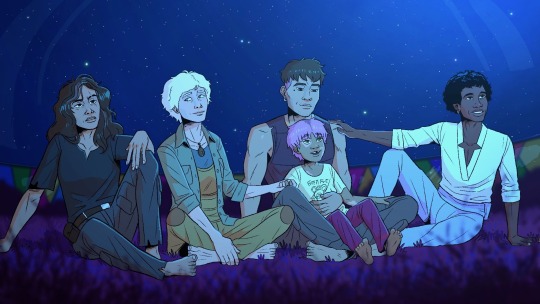
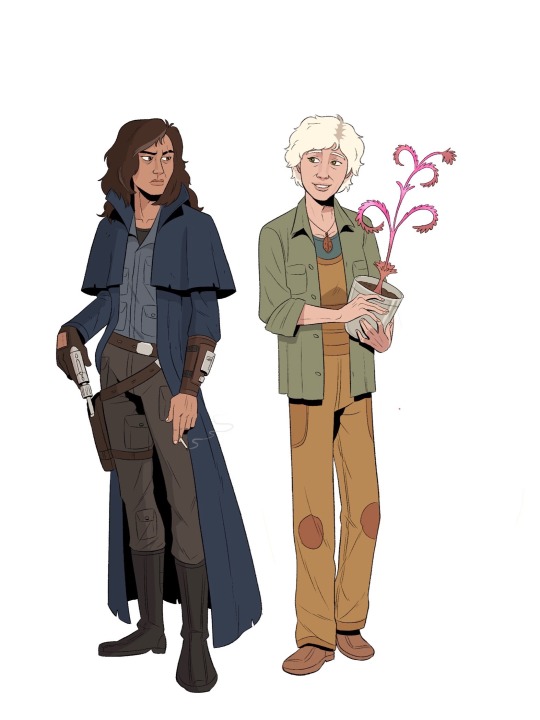
1 note
·
View note
Text
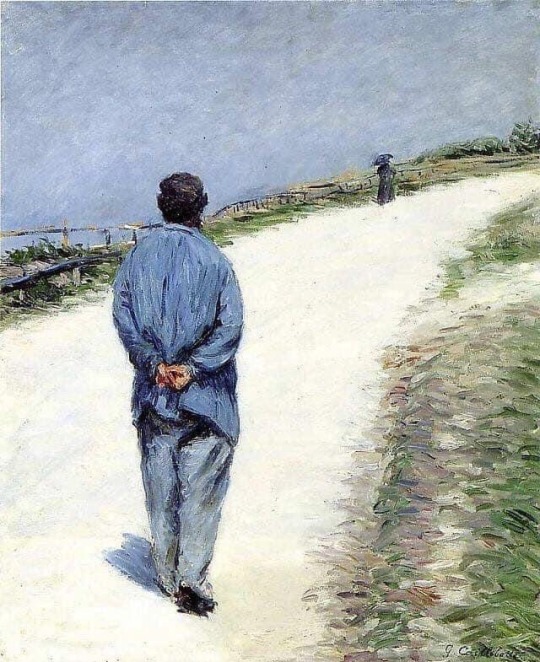
Segredos de Paris
Casos de Paris...
Em meados do século XIX, Victor Hugo estava no auge da carreira. Estava longe de imaginar que a tragédia viria bater à sua porta.
A filha mais velha, a adorada Léopoldine, está apaixonada por um jovem Charles Vacquerie, filho de um armador de Le Havre. Como tem apenas quatorze anos, teve de esperar pelo consentimento do pai, Victor Hugo, por três anos. Além disso, ele faz de tudo para atrasar o casamento, a ponto de pretextar uma paralisia da mão por não assinar o registro de casamento! Curioso: em "Les Misérables", Jean Valjean finge ter o polegar machucado para não assinar a certidão de casamento entre Marius e Cosette! Léopoldine e Charles finalmente se casam. Mas apenas sete meses depois, a tragédia acontece.
Em Villequier, na Normandia, Léopoldine e o marido embarcam em uma canoa para uma curta viagem pelo Sena. De repente, um redemoinho se precipita, bate na vela e abruptamente vira a canoa. Léopoldine não sabe nadar, Charles é um excelente nadador. Ele tenta tudo para salvar a mulher, mas os dois acabam por se afogar juntos. Leopoldina tinha apenas dezenove anos. Victor Hugo recebe a terrível notícia pela imprensa. Está arrasado. Ele é aniquilado. A amada Léopoldine já não existe. Quando chega a Villequier, os recém-casados já estão enterrados na mesma tumba. A morte da filha inspirou Victor Hugo a escrever seu poema mais famoso, "Demain, dès l’aube":
"Demain, dès l’aube, à l’heure où blanchit la campagne,
Je partirai. Vois-tu, je sais que tu m’attends.
J’irai par la forêt, j’irai par la montagne.
Je ne puis demeurer loin de toi plus longtemps."
[Amanhã, ao amanhecer, quando o campo embranquecer, eu vou embora. Veja, eu sei que você me espera. Irei pela floresta, passarei pelas montanhas. Não posso mais ficar longe de você.]
A morte de Léopoldine afeta toda a família Hugo, em particular a irmã Adèle, de 13 anos. Ela, que recebera menos atenção que a mais velha, acha que pode substituí-la no coração do pai. Mas Léopoldine permanece insubstituível e o pai inconsolável. A família vive no culto da falecida, venerando como relíquias sagradas objetos pessoais e vestidos. Ela assombra o coração do pai e continua a ofuscar a irmã mais nova. Adèle então mostra os primeiros sinais de sérios transtornos mentais. Com crises cada vez mais frequentes, é internada em um hospital psiquiátrico. Nos anos que se seguiram à morte de Léopoldine, Victor Hugo não escreveu quase nada. Nem teatro, nem romance, nem poema. A tinta secou, mas não as lágrimas.
Gustave Caillebotte, "Le Père Magloire sur la route entre Saint-Clair et Étretat", 1884. Óleo sobre tela. Coleção particular.
1 note
·
View note
Text
Javert contre Maillard
read it on the AO3 at https://ift.tt/ExIvFVX
by LadySybille
Et maintenant, il est temps de clore cette affaire.
Mais au bénéfice de qui ?
Javert ? Maillard ? Suspense !
Words: 1739, Chapters: 1/?, Language: Français
Series: Part 19 of JAVERT APRES LA SEINE...
Fandoms: Les Misérables - All Media Types, Les Misérables - Victor Hugo
Rating: Mature
Warnings: No Archive Warnings Apply
Categories: M/M
Characters: Javert (Les Misérables), Jean Valjean, Cosette Fauchelevent, Marius Pontmercy, Luc-Esprit Gillenormand
Relationships: Javert/Jean Valjean
Additional Tags: Post-Seine, Established Relationship, Fluff and Angst, Angst and Hurt/Comfort, Love
read it on the AO3 at https://ift.tt/ExIvFVX
0 notes